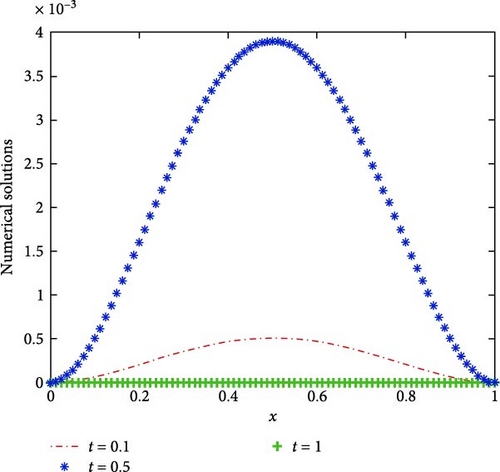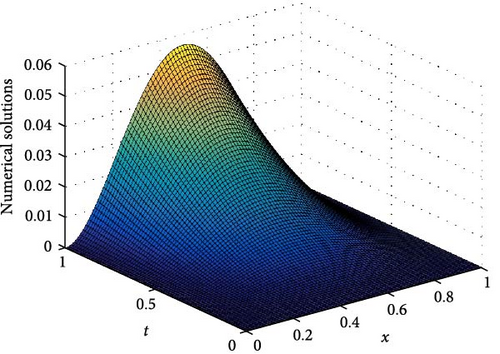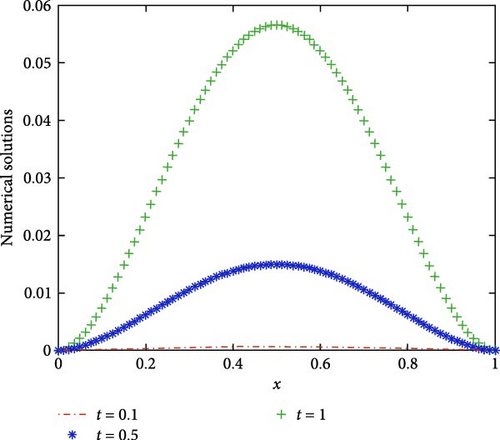A Simple and Effective Second-Order Numerical Algorithm for Tempered Fractional Differential Equation With Time Caputo-Tempered Fractional Derivative
Abstract
This paper presents an efficient numerical scheme for the space–time tempered fractional convection–diffusion equation, where the time derivative is the Caputo-tempered fractional derivative and the space derivatives are the normalized left and right Riemann–Liouville tempered fractional derivatives. The time Caputo-tempered fractional derivative is transformed into time Riemann–Liouville tempered fractional derivative by the relationship between Caputo fractional derivative and Riemann–Liouville fractional derivative. Using the tempered weighted and shifted Grünwald difference operators to approximate the time-tempered fractional derivative and the space-tempered fractional convection–diffusion term, it is obtained that the time and space directions are both second-order precision. The stability and convergence of the proposed numerical scheme are analyzed by using the energy method with a little different from the existing work. It is found that the proposed scheme is unconditionally stable and convergent with order O(τ2 + h2). Finally, some numerical examples are given to verify the effectiveness of the proposed scheme.
1. Introduction
Fractional derivative has been proposed for a long time. Due to the lack of understanding of its application in the real world, it is gradually known and studied by many scholars in the last half century. Fractional differential equations derived from fractional derivatives are widely used in many fields, such as groundwater hydrology, finance, plasma physics, and biology [5–12]. Because of the nonlocality of fractional derivatives, the analytical solutions of fractional differential equations are difficult to obtain, so it is urgent to develop numerical methods for solving fractional differential equations. Many scholars have done a lot of important work on fractional differential models and their numerical solutions [13–23].
Fractional differential equations include time-fractional differential equations, space fractional differential equations, and space–time fractional differential equations. Caputo fractional derivative generally describes time-fractional derivative, and Riemann–Liouville fractional derivatives generally describe space fractional derivatives. For Caputo fractional derivative, the idea of piecewise interpolation is generally used to approximate it, and L1 [24, 25], L1 − 2 [26], and L1 − 2σ [27] formulas are obtained. In addition, Cen et al. [28] consider the time-fractional KdV–Burgers’ equation, in which the fractional derivative of time Caputo is approximated by L2 − 1σ formula on graded meshes, and the time direction is obtained with second-order precision. Chawla et al. [29] study the generalized time-fractional Burgers’ equation and processed the time Caputo fractional derivative with the idea of Taylor expansion and finally obtain that the time direction was of second-order accuracy. Different from the time Caputo fractional derivative, the approximation of the time Caputo-tempered fractional derivative obtained by the introduction of exponential factor cannot be directly applied to the method described in the above literature. Through the connection between the Caputo fractional derivative and the Riemann–Liouville fractional derivative, the Caputo-tempered fractional derivative can be converted to the Riemann–Liouville tempered fractional derivative, and the second-order approximation for Riemann–Liouville tempered fractional derivative is obtained by using Lagrange linear interpolation [30] and quasi-compact technique [31], respectively. The Riemann–Liouville fractional derivatives are usually approximated by the Grünwald difference operators and their extensions, and many research results have been obtained [17, 18, 21, 23]. In addition, Ahmed et al. [32] propose a computational strategy based on new eighth-kind Chebyshev operational matrices for the nonlinear time-fractional generalized Kawahara equation. Leveraging the properties of these Chebyshev operational matrices to discretize the equation, it provides an effective numerical solution method. Hafez et al. [33] put forward a Jacobi rational operational approach for the time-fractional subdiffusion equation on a semi-infinite domain. By utilizing the properties of Jacobi rational functions, it addresses the problem in a semi-infinite domain. This new idea performs well in handling fractional diffusion problems with specific boundary conditions in the given domain. For more work of this team, please refer to Hafez et al. [34] and Youssri et al. [35]. At the same time, a variant of the fractional derivative is proposed, called the tempered fractional derivative, and the time-tempered fractional derivative yields the time-tempered fractional differential equation [9], the space-tempered fractional derivatives yield the space-tempered fractional differential equation [36], and the combination gives the space–time tempered fractional differential equation [3, 37, 38]. Hao et al. [30] consider the numerical scheme of the time-tempered diffusion equation, where the time-tempered fractional derivative is effectively second-order approximated by the Lagrange linear interpolation based on the tempered shifted Grünwald difference operator. Chen and Deng [37] develop a numerical scheme for space–time tempered fractional diffusion equation but only first-order precision in time and second-order precision in space. Ding and Li [31] study the higher-order numerical scheme of time Caputo-tempered fractional diffusion equation and convert Caputo-tempered fractional derivative into Riemann–Liouville tempered fractional derivative through the relationship between Caputo fractional derivative and Riemann–Liouville fractional derivative, and then an effective second-order approximation of Riemann–Liouville tempered fractional derivative is obtained by using quasi-compact technique based on the tempered shifted Grünwald difference operator. In addition, a Chebyshev pseudospectral method for the space–time tempered fractional diffusion equation is constructed by Hanert and Piret [39]. For the space-tempered fractional diffusion equation, Baeumer and Meerschaert [1] propose the first-order tempered shifted Grünwald difference operators to approximate the left and right Riemann–Liouville tempered fractional derivatives, which are developed by Li and Deng [2] into the second-order tempered weighted and shifted Grünwald difference operators. See Yu et al. [40] for the third-order quasi-compact schemes of the one-sided space-tempered fractional diffusion equation and Qiu [41] for the fourth-order numerical schemes. More numerical studies on tempered fractional differential equations can be found in [42–51]. Qiu [52] gives a second-order numerical scheme for the time-independent tempered fractional convection–diffusion equation. It should be noted that there is a lack of numerical research on space–time tempered fractional convection–diffusion equation.
The novelty of this paper is that the second-order numerical scheme of the space–time tempered fractional convection–diffusion equation is studied, where the treatment of the time Caputo-tempered fractional derivative is different from the existing work, and the second-order numerical approximation is obtained directly by using the tempered weighted and shifted Grünwald difference operator. The theoretical analysis of the numerical scheme is also simpler than the existing work [30, 31].
The remaining sections of this paper are arranged as follows. Section 2 presents some initial preparations. The detailed numerical scheme is derived in Section 3. In Section 4, the stability and convergence of the numerical scheme are proved strictly. Some numerical examples are given in Section 5. Section 6 provides a brief summary of the work in this paper.
2. Preliminary
Lemma 1. [1] Let n − 1 < ξ < n(n = 1, 2), λ ≥ 0, the shift number p is an integer, h is the step size, and ν(x) is defined on the bounded interval [a, b] and belongs to after zero extension on the interval x ∈ (−∞, a) ∪ (b, +∞). The left and right tempered shifted Grünwald type difference operators are defined as
Lemma 2. [2] Let n − 1 < ξ < n(n = 1, 2), λ ≥ 0, if the left and right tempered weighted and shifted Grünwald difference operators are defined as
Remark 1. In fact, from Baeumer and Meerschaert [1] and Li and Deng [2], it is easy to find that and have the following first-order and second-order approximations, respectively:
For the left Riemann–Liouville time-tempered fractional derivative in Problem (7), its second-order approximation is
3. Numerical Discretization
Make the time grid point tn = nτ, 0 ≤ n ≤ N, , and the space grid point ui = a + ih, 0 ≤ i ≤ M, . Let and represent the exact solution and the numerical solution at the point (xi, tn), respectively, and .
In this article, we always assume that the function u(x, t) in Problem (7) satisfies u(x, ⋅) and u(⋅, t) which belong to and , respectively, after zero extension.
4. Stability and Convergence Analysis
In this section, the stability and convergence of the numerical scheme are proved. Now, some lemmas that will be used in the proof process are given.
Lemma 3. [2] For 1 < γ < 2, λ3 ≥ 0, h > 0, if max , then the following results are satisfied:
Matrix in Equation (20) is a negative definite.
Lemma 4. [52] For 0 < β < 1, λ2 ≥ 0, h > 0, if the following condition is satisfied
Lemma 5. [52] Let λ1 ≥ 0, τ > 0.
- (i)
For , if then the following relationships are satisfied
- (ii)
For if then the following relationships are satisfied:
Lemma 6. [53] (Discrete Gronwall lemma) Assume that {kn} and {pn} are non-negative sequences, and the sequence {ϕn} satisfies
Define Υh = {υ | υ = {υi} is a grid function defined on }. For υ ∈ Υh, the corresponding discrete L2-norm is defined as .
Theorem 1. For α, β ∈ (0, 1), γ ∈ (1, 2), let and , and then the numerical Scheme (18) is unconditionally stable.
Proof. For the initial condition within a certain error, denotes the solution obtained by applying the numerical Scheme (18). Denoting it follows from Equation (20):
Multiplying the left side of both sides of Equation (21) by , it is known from Qiu [52] that matrix Q is a negative definite, as well as from Lemma 4, knowing that ; thus,
- (i)
For , we have , so from Equation (22), we can get that
(23)further obtain(24)according to Lemma 6(25) - (ii)
For we have so from Equation (22), we can get that
(26)
further obtain
In summary, the theorem is proved.
Theorem 2. For α, β ∈ (0, 1), γ ∈ (1, 2), let and , and then the numerical Scheme (18) is convergent; that is,
Proof. Let Equation (17) subtract Equation (18), similar to Equation (20) to get the following matrix formula:
Multiplying the left side of both sides of Equation (29) by , similar to the proof of Theorem 1, we rearrange to get
- (i)
For , we have , so from Equation (30), we can get that
(31)further obtain(32)according to Lemma 6(33) - (ii)
For we have so from Equation (30), we can get that
(34)
To sum up,
Thus, the theorem is proved.
5. Numerical Examples
Example 1. Consider the following tempered fractional convection–diffusion equations:
The exact solution is
Let lβ = 1, rβ = 3, lγ = 5, rγ = 7, and m = n = 2. Using the proposed numerical scheme to solve Example 1, the numerical results obtained under different (α, β, γ) and (λ1, λ2, λ3) and step sizes (τ = h) are shown in Table 1. From Table 1, we can find that the numerical results are consistent with the theoretical analysis. The images of the numerical solutions are also shown in Figures 1 and 2.
| (α, β, γ) | h = τ | λ1 = 0.1 | λ1 = 1 | ||
|---|---|---|---|---|---|
| λ2 = 0.2 | λ2 = 2 | ||||
| λ3 = 1 | λ3 = 3 | ||||
| Order | Order | ||||
| (0.2, 0.5, 1.8) | 1/10 | 7.6792e−07 | — | 2.0326e−07 | — |
| 1/20 | 2.1300e−07 | 1.8501 | 8.2863e−08 | 1.2945 | |
| 1/40 | 5.5403e−08 | 1.9428 | 2.4849e−08 | 1.7375 | |
| 1/80 | 1.3988e−08 | 1.9858 | 6.6194e−09 | 1.9084 | |
| (0.2, 0.8, 1.5) | 1/10 | 1.2185e−06 | — | 1.1711e−06 | — |
| 1/20 | 3.7007e−07 | 1.7192 | 3.3470e−07 | 1.8069 | |
| 1/40 | 9.8470e−08 | 1.9100 | 8.4278e−08 | 1.9896 | |
| 1/80 | 2.4816e−08 | 1.9884 | 2.1220e−08 | 1.9897 | |
| (0.5, 0.2, 1.8) | 1/10 | 3.4879e−06 | — | 2.2053e−06 | — |
| 1/20 | 9.7554e−07 | 1.8381 | 7.8275e−07 | 1.4944 | |
| 1/40 | 2.5566e−07 | 1.9320 | 2.2514e−07 | 1.7977 | |
| 1/80 | 6.5053e−08 | 1.9745 | 5.9587e−08 | 1.9178 | |
| (0.5, 0.8, 1.2) | 1/10 | 3.3155e−06 | — | 2.8933e−05 | — |
| 1/20 | 1.7777e−06 | 0.8992 | 1.2486e−05 | 1.2124 | |
| 1/40 | 5.7928e−07 | 1.6177 | 3.5922e−06 | 1.7974 | |
| 1/80 | 1.5799e−07 | 1.8744 | 9.2582e−07 | 1.9561 | |
| (0.8, 0.2, 1.5) | 1/10 | 1.8438e−05 | — | 1.1337e−05 | — |
| 1/20 | 5.5050e−06 | 1.7439 | 4.6972e−06 | 1.2712 | |
| 1/40 | 1.4726e−06 | 1.9024 | 1.4374e−06 | 1.7083 | |
| 1/80 | 3.7748e−07 | 1.9639 | 3.8962e−07 | 1.8833 | |
| (0.8, 0.5, 1.2) | 1/10 | 1.8675e−05 | — | 4.4963e−05 | — |
| 1/20 | 6.9562e−06 | 1.4247 | 2.5007e−05 | 0.8464 | |
| 1/40 | 2.0591e−06 | 1.7563 | 7.7313e−06 | 1.6935 | |
| 1/80 | 5.4925e−07 | 1.9065 | 2.0174e−06 | 1.9382 | |
Example 2. Consider the following tempered fractional convection–diffusion equations:
The exact solution is
Let lβ = 1, rβ = 2, lγ = 3, rγ = 4, and m = n = 2. Using the proposed numerical scheme to solve Example 2, the error, observation order, and CPU time obtained under different (α, β, γ) and step sizes (τ = h) are shown in Table 2. We can see from Table 2 that the numerical results are in agreement with the theoretical analysis. The images of the numerical solutions are also shown in Figures 3 and 4.

| (α, β, γ) | λ1 = 0.1 | λ2 = 0.2 | λ3 = 0.5 | CPU time(s) |
|---|---|---|---|---|
| h = τ | Order | |||
| (0.2, 0.5, 1.8) | 1/10 | 9.0027e−04 | — | 0.0538 |
| 1/20 | 2.2508e−04 | 1.9999 | 0.1525 | |
| 1/40 | 5.4294e−05 | 2.0516 | 0.1541 | |
| 1/80 | 1.2889e−05 | 2.0747 | 0.3635 | |
| (0.2, 0.8, 1.5) | 1/10 | 4.9078e−04 | — | 0.0535 |
| 1/20 | 1.4967e−04 | 1.7133 | 0.1527 | |
| 1/40 | 4.0599e−05 | 1.8823 | 0.1553 | |
| 1/80 | 1.0609e−05 | 1.9362 | 0.3473 | |
| (0.5, 0.2, 1.8) | 1/10 | 6.9563e−04 | — | 0.0545 |
| 1/20 | 1.6891e−04 | 2.0421 | 0.1524 | |
| 1/40 | 3.9553e−05 | 2.0944 | 0.1551 | |
| 1/80 | 9.1303e−06 | 2.1151 | 0.3538 | |
| (0.5, 0.8, 1.2) | 1/10 | 1.9091e−03 | — | 0.0547 |
| 1/20 | 4.5829e−04 | 2.0586 | 0.1539 | |
| 1/40 | 1.1162e−04 | 2.0377 | 0.1552 | |
| 1/80 | 2.7968e−05 | 1.9978 | 0.3558 | |
| (0.8, 0.2, 1.5) | 1/10 | 5.8513e−04 | — | 0.0539 |
| 1/20 | 1.6304e−04 | 1.8435 | 0.1525 | |
| 1/40 | 4.6538e−05 | 1.8087 | 0.1555 | |
| 1/80 | 1.3188e−05 | 1.8192 | 0.3538 | |
| (0.8, 0.5, 1.2) | 1/10 | 2.7043e−03 | — | 0.0544 |
| 1/20 | 7.0178e−04 | 1.9462 | 0.1547 | |
| 1/40 | 1.7523e−04 | 2.0018 | 0.1564 | |
| 1/80 | 4.3786e−05 | 2.0007 | 0.3556 | |
6. Conclusions
In this paper, we focus on the higher-order numerical scheme of tempered fractional convection–diffusion equation with time Caputo-tempered fractional derivative. Different from the existing work, the discretization of time Caputo-tempered fractional derivative is directly performed by using the second-order tempered weighted and shifted Grünwald difference operator, and the proof of stability and convergence is simpler. Finally, some numerical examples are given to verify the effectiveness of the proposed scheme. In the following research work, we expect to propose high-order quasi-compact schemes for the tempered fractional diffusion equation and even the tempered fractional convection–diffusion equation. In addition, we hope to extend the problem with smooth solutions to the case of nonsmooth solutions and to develop the efficient numerical schemes.



Conflicts of Interest
The authors declare no conflicts of interest.
Author Contributions
Lizan Wang and Jianxin Li contributed equally to this work.
Funding
This research is supported by the Xinjiang University of Political Science and Law President Fund (XZZK2024008).
Acknowledgments
This research is supported by the Xinjiang University of Political Science and Law President Fund (XZZK2024008).
Open Research
Data Availability Statement
The data that support the findings of this study are available from the corresponding author upon reasonable request.




